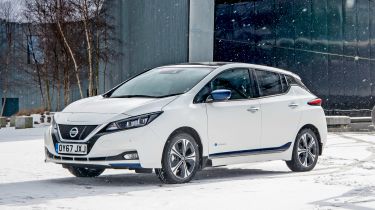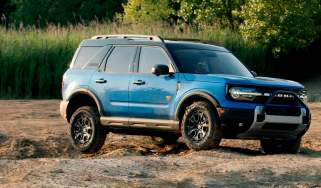Electric cars in winter: the truth about cold weather range
An electric car won’t do as many miles per charge in colder weather, but what else do you need to know about driving in the winter? Read on to find out…

Make no mistake: electric cars are less efficient in the winter. The cold weather affects battery performance, reducing range and forcing you to charge more often. But with EVs accounting for 14.5 per cent of new car registrations, what sort of mileage might go missing? And can you still drive an EV in sub-zero temperatures?
The short answer to the second question, of course, is yes. For years (thanks to strong incentives) Norway’s electric-car uptake far surpassed that of any other global market – in spite of its extreme winters. The UK, in contrast, has a relatively mild climate, so driving an EV year-round over here should be a piece of cake.
Some firms, such as Renault, offer online calculators that let you work out what kind of range you can expect when temperatures drop. As an example, if you’re running a Zoe in normal conditions (20 degrees celsius, at a steady 31mph), Renault reckons you’ll get 234 miles on a full charge.
If the temperature were to drop to just five degrees and you ran around everywhere with the heater on, that figure could topple to 187 miles according to Renault’s sums – a 20 per cent reduction in range. It’s worse still when things fall below freezing; at minus five degrees a Zoe R135 will return just 152 miles before needing to be plugged in. It’s important to note that the bigger the battery, the greater potential for energy loss.
Why does cold weather reduce EV efficiency?
Cold temperatures adversely affect EV batteries because they rely on chemical reactions to store and release electricity. Lithium-ion batteries – the most common cells used in electric and hybrid cars – work when lithium ions move from the anode to the cathode; cold slows this process down and restricts battery performance. The result can be a dramatic loss in usable range.
Yet for many drivers, even 152 miles will be plenty. If you’ve got a short commute and can charge up at work or at home, you could even take advantage of pre-conditioning – heating your car’s cabin, defrosting the windows and switching on the heated seats – before you leave in the morning.
This will not only keep you and your passengers nice and toasty, it can also help condition the battery to limit energy loss; the warmer the battery, the more likely it is to perform at its best. Cars fitted with auxiliary heat pumps often perform better in winter for this reason; if you live in an area particularly affected by the cold, we’d seriously consider specifying a heat pump as an optional extra.
Do low temperatures impact charging speeds?
While there are no added dangers when charging your car in rain or snow, another adverse effect of the cold is that charging speeds from public rapid chargers may be slower. Tesla admits that extreme weather can result in reduced charging speeds at its Supercharger stations, and the same is likely to be true of other networks.
But apart from keeping an eye on your model’s predicted range, the weather and prevailing road conditions, there isn’t much for you to worry about when driving an electric car during the winter months.
True, electric cars are generally heavier than their equivalent petrol and diesel models – slides may be harder to control – but common sense dictates that we should all drive more carefully in the cold or wet, regardless of whether we’re in an electric car or not. Any handling disadvantages can, of course, be mitigated somewhat by investing in a good set of winter tyres, which is just as important for an EV as it is for a petrol car.
So yes, you can still drive an electric car through the winter. Be sure to perform regular maintenance on your car – check your windscreen washers, anti-freeze and tyre pressures at a bare minimum – and you should be fine. Oh, and remember: at least you won’t be left standing beside the car in sleeting rain for five minutes filling your tank with diesel.
Are some electric cars better than others in the cold?
Not all electric cars are the same and our non-scientific testing of various different EV models has revealed quite the disparity in the way range is effected by the cold. At one end of the scale, the Hyundai Ioniq Electric continued to return efficiency of over 4 miles per kWh in mixed driving even when the average ambient temperature fell close to zero.
By contrast, a motorway journey in the MG4 EV saw returns of 3.1mi/kWh in cold weather where the same journeys had given us 3.8mi/kWh in the summer months. The Subaru Soltera, meanwhile, (sister car to the Toyota bZ4X and Lexus RX) seemed to be particularly badly affected. It averaged just 2.5mi/kWh in near-zero temperatures, and that was with the climate control switched off.
It's worth remembering that petrol and diesel cars are not immune from a decline in efficiency in cold weather and this isn't just caused by the increased need to heat the passenger compartment. Many of the systems in modern internal combustion engines need to get up to temperature before they can operate at maximum efficiency, a process that will take longer when it's cold. The differences between warm and cold weather efficiency do tend to be less pronounced than in an EV, though.
How to get more from your electric car
Wondering how you can eke out the maximum mileage from your electric car during the colder months? Here are our top tips.
Plug in and pre-heat your car
If you can, it’s always worth pre-heating the cabin while your car is plugged in. That way you’re using mains power to warm the car, rather than sapping range by using the battery after you set off. Plugging in more often than usual can save you from range anxiety, too.
Use heated seats (and turn off heater!)
An electric car’s heated seats and heated steering wheel use far less energy than the fan or air-conditioning unit. If you can bear it, switching off the A/C can add considerably to your projected range.
Slow down
It might sound obvious, but the faster you drive, the less efficient your car is going to be. Even dropping from 70mph to 65mph on the motorway could make a big difference to range. Driving gently and using the car’s Eco setting can help, too.
Use your sat-nav
The sat-nav systems in most EVs can plot the most efficient route when you enter a destination – potentially saving precious miles. The same is now true of Google Maps, if you prefer using Apple CarPlay or Android Auto.
Maximise regenerative braking
Turning up the level of your electric car’s regenerative braking can help capture energy that would otherwise be lost when slowing or coasting. Beware, however, that in heavy snow or ice, such a system can cause your wheels to slip; we’d switch it off in extreme conditions.
Is your car prepared for the winter? Check out our winter car checklist for more...
Best winter cars
| • Best electric SUVS to buy now | • Best SUVs to buy now |
| • Best crossovers to buy now | • Best small 4x4s to buy now |
Get ready for winter on the roads
Top tips for winter driving
Find a car with the experts




